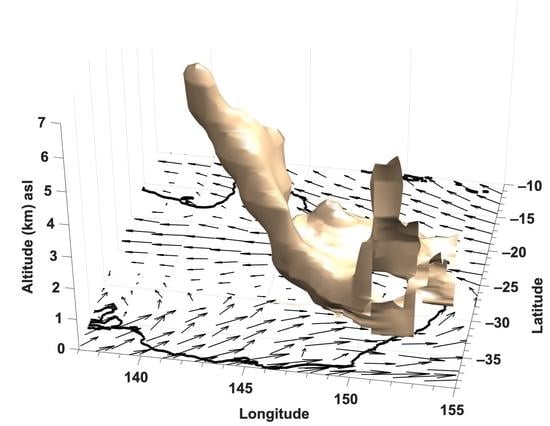Three-Dimensional Distribution of Biomass Burning Aerosols from Australian Wildfires Observed by TROPOMI Satellite Observations
Abstract
:1. Introduction
2. Materials and Methods
2.1. The AEROS5P Method
2.1.1. Inputs
2.1.2. Forward Calculations of Reflectance Spectra
2.1.3. Inversion Procedure
2.2. Other Aerosol Observations
3. Comparison of AEROS5P Retrievals with Other Aerosol Products
3.1. Aerosol Optical Depth
3.2. Aerosol Extinction Profiles
4. Daily Evolution of the 3D Distribution of Biomass Burning Aerosol Plumes
5. Conclusions
Supplementary Materials
Author Contributions
Funding
Data Availability Statement
Acknowledgments
Conflicts of Interest
References
- Yu, P.; Davis, S.M.; Toon, O.B.; Portmann, R.W.; Bardeen, C.G.; Barnes, J.E.; Telg, H.; Maloney, C.; Rosenlof, K.H. Persistent Stratospheric Warming Due to 2019–2020 Australian Wildfire Smoke. Geophys. Res. Lett. 2021, 48. [Google Scholar] [CrossRef]
- Khaykin, S.; Legras, B.; Bucci, S.; Sellitto, P.; Isaksen, L.; Tencé, F.; Bekki, S.; Bourassa, A.; Rieger, L.; Zawada, D.; et al. The 2019/20 Australian Wildfires Generated a Persistent Smoke-Charged Vortex Rising up to 35 Km Altitude. Commun. Earth Environ. 2020, 1, 22. [Google Scholar] [CrossRef]
- Sellitto, P.; Belhadji, R.; Kloss, C.; Legras, B. Radiative Impacts of the Australian Bushfires 2019–2020—Part 1: Large-Scale Radiative Forcing. EGUsphere 2022, 1–20. [Google Scholar] [CrossRef]
- Chen, L.; Li, Q.; Wu, D.; Sun, H.; Wei, Y.; Ding, X.; Chen, H.; Cheng, T.; Chen, J. Size distribution and chemical composition of primary particles emitted during open biomass burning processes: Impacts on cloud condensation nuclei activation. Sci. Total Environ. 2019, 674, 179–188. [Google Scholar] [CrossRef]
- Li, Y. Cloud Condensation Nuclei Activity and Hygroscopicity of Fresh and Aged Biomass Burning Particles. Pure Appl. Geophys. 2018, 176, 345–356. [Google Scholar] [CrossRef] [Green Version]
- Kennedy, I.M. The health effects of combustion-generated aerosols. Proc. Combust. Inst. 2007, 31, 2757–2770. [Google Scholar] [CrossRef]
- Freitas, S.R.; Longo, K.M.; Chatfield, R.; Latham, D.; Dias, M.A.F.S.; Andreae, M.O.; Prins, E.; Santos, J.C.; Gielow, R.; Carvalho, J.A., Jr. Including the sub-grid scale plume rise of vegetation fires in low resolution atmospheric transport models. Atmos. Chem. Phys. 2007, 7, 3385–3398. [Google Scholar] [CrossRef] [Green Version]
- Turquety, S.; Menut, L.; Siour, G.; Mailler, S.; Hadji-Lazaro, J.; George, M.; Clerbaux, C.; Hurtmans, D.; Coheur, P.-F. APIFLAME v2.0 biomass burning emissions model: Impact of refined input parameters on atmospheric concentration in Portugal in summer 2016. Geosci. Model Dev. 2020, 13, 2981–3009. [Google Scholar] [CrossRef]
- Kahn, R.A.; Chen, Y.; Nelson, D.L.; Leung, F.-Y.; Li, Q.; Diner, D.J.; Logan, J.A. Wildfire smoke injection heights: Two perspectives from space. Geophys. Res. Lett. 2008, 35. [Google Scholar] [CrossRef] [Green Version]
- Sofiev, M.; Ermakova, T.; Vankevich, R. Evaluation of the smoke-injection height from wild-land fires using remote-sensing data. Atmos. Chem. Phys. 2012, 12, 1995–2006. [Google Scholar] [CrossRef] [Green Version]
- Sanders, A.F.J.; de Haan, J.F.; Sneep, M.; Apituley, A.; Stammes, P.; Vieitez, M.O.; Tilstra, L.G.; Tuinder, O.N.E.; Koning, C.E.; Veefkind, J.P. Evaluation of the operational Aerosol Layer Height retrieval algorithm for Sentinel-5 Precursor: Application to O2 A band observations from GOME-2A. Atmos. Meas. Tech. 2015, 8, 4947–4977. [Google Scholar] [CrossRef] [Green Version]
- Cuesta, J.; Eremenko, M.; Flamant, C.; Dufour, G.; Laurent, B.; Bergametti, G.; Höpfner, M.; Orphal, J.; Zhou, D. Three-dimensional distribution of a major desert dust outbreak over East Asia in March 2008 derived from IASI satellite observations. J. Geophys. Res. Atmos. 2015, 120, 7099–7127. [Google Scholar] [CrossRef] [Green Version]
- Hess, M.; Koepke, P.; Schult, I. Optical Properties of Aerosols and Clouds: The Software Package OPAC. Bull. Am. Meteorol. Soc. 1998, 79, 831–844. [Google Scholar] [CrossRef]
- Callies, J.; Corpaccioli, E.; Eisinger, M.; Lefebvre, A.; Munro, R.; Perez-Albinana, A.; Ricciarelli, B.; Calamai, L.; Gironi, G.; Veratti, R.; et al. GOME-2 ozone instrument onboard the European METOP satellites. SPIE Polariz. Sci. Remote Sens. 2004, 5158, 60–70. [Google Scholar] [CrossRef]
- Veefkind, J.P.; Aben, I.; McMullan, K.; Förster, H.; de Vries, J.; Otter, G.; Claas, J.; Eskes, H.J.; de Haan, J.F.; Kleipool, Q.; et al. TROPOMI on the ESA Sentinel-5 Precursor: A GMES mission for global observations of the atmospheric composition for climate, air quality and ozone layer applications. Remote Sens. Environ. 2012, 120, 70–83. [Google Scholar] [CrossRef]
- Bond, T.C.; Doherty, S.J.; Fahey, D.W.; Forster, P.M.; Berntsen, T.; DeAngelo, B.J.; Flanner, M.G.; Ghan, S.; Kärcher, B.; Koch, D.; et al. Bounding the role of black carbon in the climate system: A scientific assessment. J. Geophys. Res. Atmos. 2013, 118, 5380–5552. [Google Scholar] [CrossRef]
- Singh, S.; Fiddler, M.N.; Bililign, S. Measurement of size-dependent single scattering albedo of fresh biomass burning aerosols using the extinction-minus-scattering technique with a combination of cavity ring-down spectroscopy and nephelometry. Atmos. Chem. Phys. 2016, 16, 13491–13507. [Google Scholar] [CrossRef] [Green Version]
- Konovalov, I.B.; Golovushkin, N.A.; Beekmann, M.; Andreae, M.O. Insights into the aging of biomass burning aerosol from satellite observations and 3D atmospheric modeling: Evolution of the aerosol optical properties in Siberian wildfire plumes. Atmos. Chem. Phys. 2021, 21, 357–392. [Google Scholar] [CrossRef]
- Hosseini, S.; Li, Q.; Cocker, D.; Weise, D.; Miller, A.; Shrivastava, M.; Miller, J.W.; Mahalingam, S.; Princevac, M.; Jung, H. Particle size distributions from laboratory-scale biomass fires using fast response instruments. Atmos. Chem. Phys. 2010, 10, 8065–8076. [Google Scholar] [CrossRef] [Green Version]
- Sandvik, O.S.; Friberg, J.; Martinsson, B.G.; Van Velthoven, P.F.J.; Hermann, M.; Zahn, A. Intercomparison of in-situ aircraft and satellite aerosol measurements in the stratosphere. Sci. Rep. 2019, 9, 15576. [Google Scholar] [CrossRef] [Green Version]
- Winker, D.M.; Tackett, J.L.; Getzewich, B.J.; Liu, Z.; Vaughan, M.A.; Rogers, R.R. The global 3-D distribution of tropospheric aerosols as characterized by CALIOP. Atmos. Chem. Phys. 2013, 13, 3345–3361. [Google Scholar] [CrossRef] [Green Version]
- Chen, X.; Wang, J.; Xu, X.; Zhou, M.; Zhang, H.; Garcia, L.C.; Colarco, P.R.; Janz, S.J.; Yorks, J.; McGill, M.; et al. First retrieval of absorbing aerosol height over dark target using TROPOMI oxygen B band: Algorithm development and application for surface particulate matter estimates. Remote Sens. Environ. 2021, 265, 112674. [Google Scholar] [CrossRef]
- Rao, L.; Xu, J.; Efremenko, D.S.; Loyola, D.G.; Doicu, A. Hyperspectral Satellite Remote Sensing of Aerosol Parameters: Sensitivity Analysis and Application to TROPOMI/S5P. Front. Environ. Sci. 2022, 9. [Google Scholar] [CrossRef]
- Diner, D.; Beckert, J.; Reilly, T.; Bruegge, C.; Conel, J.; Kahn, R.; Martonchik, J.; Ackerman, T.; Davies, R.; Gerstl, S.; et al. Multi-angle Imaging SpectroRadiometer (MISR) instrument description and experiment overview. IEEE Trans. Geosci. Remote Sens. 1998, 36, 1072–1087. [Google Scholar] [CrossRef]
- Limbacher, J.A.; Kahn, R.A. Updated MISR dark water research aerosol retrieval algorithm—Part 1: Coupled 1.1 km ocean surface chlorophyll a retrievals with empirical calibration corrections. Atmos. Meas. Tech. 2017, 10, 1539–1555. [Google Scholar] [CrossRef] [Green Version]
- Garay, M.J.; Witek, M.L.; Kahn, R.A.; Seidel, F.C.; Limbacher, J.A.; Bull, M.A.; Diner, D.J.; Hansen, E.G.; Kalashnikova, O.V.; Lee, H.; et al. Introducing the 4.4 Km Spatial Resolution MISR Aerosol Product. Atmos. Meas. Tech. Discuss. 2019, 20, 1–58. [Google Scholar] [CrossRef]
- Vandenbussche, S.; Kochenova, S.; Vandaele, A.C.; Kumps, N.; De Mazière, M. Retrieval of Desert Dust Aerosol Vertical Profiles from IASI Measurements in the TIR Atmospheric Window. Atmos. Meas. Tech. 2013, 6, 2577–2591. [Google Scholar] [CrossRef] [Green Version]
- Cuesta, J.; Flamant, C.; Eremenko, M.; Dufour, G.; Laurent, B.; Bergametti, G.; Aires, F.; Ryder, C. Three-Dimensional Distribution of a Major Saharan Dust Outbreak in June 2011 Derived from IASI Satellite Observations. In Proceedings of the 4th IASI International Conference, Antibes Juan-les-Pins, France, 11–15 April 2016. [Google Scholar]
- Cuesta, J.; Flamant, C.; Gaetani, M.; Knippertz, P.; Fink, A.H.; Chazette, P.; Eremenko, M.; Dufour, G.; Di Biagio, C.; Formenti, P. Three-dimensional pathways of dust over the Sahara during summer 2011 as revealed by new Infrared Atmospheric Sounding Interferometer observations. Q. J. R. Meteorol. Soc. 2020, 146. [Google Scholar] [CrossRef]
- Clarisse, L.; Coheur, P.-F.; Prata, F.; Hadji-Lazaro, J.; Hurtmans, D.; Clerbaux, C. A unified approach to infrared aerosol remote sensing and type specification. Atmos. Chem. Phys. 2013, 13, 2195–2221. [Google Scholar] [CrossRef] [Green Version]
- Bernath, P.; Boone, C.; Crouse, J. Wildfire smoke destroys stratospheric ozone. Science 2022, 375, 1292–1295. [Google Scholar] [CrossRef]
- Guermazi, H.; Sellitto, P.; Cuesta, J.; Eremenko, M.; Lachatre, M.; Mailler, S.; Carboni, E.; Salerno, G.; Caltabiano, T.; Menut, L.; et al. Quantitative Retrieval of Volcanic Sulphate Aerosols from IASI Observations. Remote Sens. 2021, 13, 1808. [Google Scholar] [CrossRef]
- Boer, M.M.; Resco De Dios, V.; Bradstock, R.A. Unprecedented burn area of Australian mega forest fires. Nat. Clim. Chang. 2020, 10, 171–172. [Google Scholar] [CrossRef]
- Filkov, A.I.; Ngo, T.; Matthews, S.; Telfer, S.; Penman, T.D. Impact of Australia’s Catastrophic 2019/20 Bushfire Season on Communities and Environment. Retrospective Analysis and Current Trends. J. Saf. Sci. Resil. 2020, 1, 44–56. [Google Scholar] [CrossRef]
- Steck, T. Methods for determining regularization for atmospheric retrieval problems. Appl. Opt. 2002, 41, 1788–1797. [Google Scholar] [CrossRef]
- Liu, X.; Bhartia, P.K.; Chance, K.; Spurr, R.J.D.; Kurosu, T.P. Ozone profile retrievals from the Ozone Monitoring Instrument. Atmos. Chem. Phys. 2010, 10, 2521–2537. [Google Scholar] [CrossRef] [Green Version]
- Cuesta, J.; Eremenko, M.; Liu, X.; Dufour, G.; Cai, Z.; Höpfner, M.; von Clarmann, T.; Sellitto, P.; Foret, G.; Gaubert, B.; et al. Satellite observation of lowermost tropospheric ozone by multispectral synergism of IASI thermal infrared and GOME-2 ultraviolet measurements over Europe. Atmos. Chem. Phys. 2013, 13, 9675–9693. [Google Scholar] [CrossRef] [Green Version]
- Rodgers, C.D. Inverse Methods For Atmospheric Sounding: Theory and Practice; World Scientific: Singapore, 2000. [Google Scholar]
- Wang, P.; Tuinder, O.N.E.; Tilstra, L.G.; de Graaf, M.; Stammes, P. Interpretation of FRESCO cloud retrievals in case of absorbing aerosol events. Atmos. Chem. Phys. 2012, 12, 9057–9077. [Google Scholar] [CrossRef] [Green Version]
- Ludewig, A.; Kleipool, Q.; Bartstra, R.; Landzaat, R.; Leloux, J.; Loots, E.; Meijering, P.; van der Plas, E.; Rozemeijer, N.; Vonk, F.; et al. In-flight calibration results of the TROPOMI payload on board the Sentinel-5 Precursor satellite. Atmos. Meas. Tech. 2020, 13, 3561–3580. [Google Scholar] [CrossRef]
- Tropomi Monitoring Portal. Available online: http://mps.tropomi.eu/dashboard (accessed on 31 March 2022).
- Torres, O.; Tanskanen, A.; Veihelmann, B.; Ahn, C.; Braak, R.; Bhartia, P.; Veefkind, P.; Levelt, P.P. Aerosols and surface UV products from Ozone Monitoring Instrument observations: An overview. J. Geophys. Res. Earth Surf. 2007, 112. [Google Scholar] [CrossRef] [Green Version]
- Available online: https://s5phub.copernicus.eu/ (accessed on 6 October 2021).
- Platnick, S.; Meyer, K.; Wind, G.; Holz, R.E.; Amarasinghe, N. The NASA MODIS-VIIRS Continuity Cloud Optical Properties Products. Remote Sens. 2021, 13, 2. [Google Scholar] [CrossRef]
- Earthdata Search. Available online: https://search.earthdata.nasa.gov/ (accessed on 31 March 2022).
- Lutz, R.; Loyola, D.; García, S.G.; Romahn, F. OCRA radiometric cloud fractions for GOME-2 on MetOp-A/B. Atmos. Meas. Tech. 2016, 9, 2357–2379. [Google Scholar] [CrossRef] [Green Version]
- Loyola, D.G.; García, S.G.; Lutz, R.; Argyrouli, A.; Romahn, F.; Spurr, R.J.D.; Pedergnana, M.; Doicu, A.; García, V.M.; Schüssler, O. The operational cloud retrieval algorithms from TROPOMI on board Sentinel-5 Precursor. Atmos. Meas. Tech. 2018, 11, 409–427. [Google Scholar] [CrossRef] [Green Version]
- Hersbach, H.; Bell, B.; Berrisford, P.; Hirahara, S.; Horányi, A.; Muñoz-Sabater, J.; Nicolas, J.; Peubey, C.; Radu, R.; Schepers, D.; et al. The ERA5 global reanalysis. Q. J. R. Meteorol. Soc. 2020, 146, 1999–2049. [Google Scholar] [CrossRef]
- Rothman, L.S.; Gordon, I.E.; Babikov, Y.; Barbe, A.; Benner, D.C.; Bernath, P.F.; Birk, M.; Bizzocchi, L.; Boudon, V.; Brown, L.R.; et al. The HITRAN2012 molecular spectroscopic database. J. Quant. Spectrosc. Radiat. Transf. 2013, 130, 4–50. [Google Scholar] [CrossRef] [Green Version]
- Chance, K.; Kurucz, R. An improved high-resolution solar reference spectrum for earth’s atmosphere measurements in the ultraviolet, visible, and near infrared. J. Quant. Spectrosc. Radiat. Transf. 2010, 111, 1289–1295. [Google Scholar] [CrossRef]
- Sentinel-5p+ Innovation. Available online: https://www.grasp-sas.com/projects/aod-brdf_sentinel-5p-innovation/ (accessed on 31 March 2022).
- Sarpong, E.; Smith, D.; Pokhrel, R.; Fiddler, M.N.; Bililign, S. Refractive Indices of Biomass Burning Aerosols Obtained from African Biomass Fuels Using RDG Approximation. Atmosphere 2020, 11, 62. [Google Scholar] [CrossRef] [Green Version]
- Tran, H.; Boulet, C.; Hartmann, J.-M. Line mixing and collision-induced absorption by oxygen in the A band: Laboratory measurements, model, and tools for atmospheric spectra computations. J. Geophys. Res. Earth Surf. 2006, 111. [Google Scholar] [CrossRef] [Green Version]
- ISRF Dataset. Tropomi. Available online: http://www.tropomi.eu/data-products/isrf-dataset (accessed on 31 March 2022).
- Spurr, R.J. VLIDORT: A linearized pseudo-spherical vector discrete ordinate radiative transfer code for forward model and retrieval studies in multilayer multiple scattering media. J. Quant. Spectrosc. Radiat. Transf. 2006, 102, 316–342. [Google Scholar] [CrossRef]
- Spurr, R.; Christi, M. On the generation of atmospheric property Jacobians from the (V)LIDORT linearized radiative transfer models. J. Quant. Spectrosc. Radiat. Transf. 2014, 142, 109–115. [Google Scholar] [CrossRef]
- Peterson, D.A.; Fromm, M.D.; McRae, R.H.D.; Campbell, J.R.; Hyer, E.J.; Taha, G.; Camacho, C.P.; Kablick, G.P.; Schmidt, C.C.; DeLand, M.T. Australia’s Black Summer pyrocumulonimbus super outbreak reveals potential for increasingly extreme stratospheric smoke events. NPJ Clim. Atmos. Sci. 2021, 4, 1–16. [Google Scholar] [CrossRef]
- Zoogman, P.; Liu, X.; Chance, K.; Sun, Q.; Schaaf, C.; Mahr, T.; Wagner, T. A climatology of visible surface reflectance spectra. J. Quant. Spectrosc. Radiat. Transf. 2016, 180, 39–46. [Google Scholar] [CrossRef]
- Clark, R.N.; Swayze, G.A.; Wise, R.A.; Livo, K.E.; Hoefen, T.M.; Kokaly, R.F.; Sutley, S.J. USGS Digital Spectral Library splib06a; US Geological Survey: Denver, CO, USA, 2007.
- Tikhonov, A.N. On the Solution of Ill-Posed Problems and the Method of Regularization. In Doklady Akademii Nauk; Russian Academy of Sciences: Saint Petersburg, Russia, 1963; Volume 151, pp. 501–504. [Google Scholar]
- Eremenko, M.; Dufour, G.; Foret, G.; Keim, C.; Orphal, J.; Beekmann, M.; Bergametti, G.; Flaud, J.-M. Tropospheric ozone distributions over Europe during the heat wave in July 2007 observed from infrared nadir spectra recorded by IASI. Geophys. Res. Lett. 2008, 35. [Google Scholar] [CrossRef]
- Giles, D.M.; Sinyuk, A.; Sorokin, M.G.; Schafer, J.S.; Smirnov, A.; Slutsker, I.; Eck, T.F.; Holben, B.N.; Lewis, J.R.; Campbell, J.R.; et al. Advancements in the Aerosol Robotic Network (AERONET) Version 3 database – automated near-real-time quality control algorithm with improved cloud screening for Sun photometer aerosol optical depth (AOD) measurements. Atmos. Meas. Tech. 2019, 12, 169–209. [Google Scholar] [CrossRef] [Green Version]
- AERONET, Aerosol Robotic Network. Available online: https://aeronet.gsfc.nasa.gov/ (accessed on 10 January 2020).
- Bilal, M.; Qiu, Z.; Campbell, J.R.; Spak, S.N.; Shen, X.; Nazeer, M. A New MODIS C6 Dark Target and Deep Blue Merged Aerosol Product on a 3 km Spatial Grid. Remote Sens. 2018, 10, 463. [Google Scholar] [CrossRef] [Green Version]
- Fernald, F.G. Analysis of atmospheric lidar observations: Some comments. Appl. Opt. 1984, 23, 652–653. [Google Scholar] [CrossRef]
- Fernald, F.G.; Herman, B.M.; Reagan, J.A. Determination of Aerosol Height Distributions by Lidar. J. Appl. Meteorol. 1972, 11, 482–489. [Google Scholar] [CrossRef] [Green Version]
- Landgraf, J.; de Brugh, J.A.; Scheepmaker, R.; Borsdorff, T.; Hu, H.; Houweling, S.; Butz, A.; Aben, I.; Hasekamp, O. Carbon monoxide total column retrievals from TROPOMI shortwave infrared measurements. Atmos. Meas. Tech. 2016, 9, 4955–4975. [Google Scholar] [CrossRef] [Green Version]
- Borsdorff, T.; de Brugh, J.A.; Hu, H.; Hasekamp, O.; Sussmann, R.; Rettinger, M.; Hase, F.; Gross, J.; Schneider, M.; Garcia, O.; et al. Mapping carbon monoxide pollution from space down to city scales with daily global coverage. Atmos. Meas. Tech. 2018, 11, 5507–5518. [Google Scholar] [CrossRef] [Green Version]
- Giglio, L.; Schroeder, W.; Justice, C.O. The collection 6 MODIS active fire detection algorithm and fire products. Remote Sens. Environ. 2016, 178, 31–41. [Google Scholar] [CrossRef] [Green Version]
- Stull, R.B. An Introduction to Boundary Layer Meteorology; Springer Science & Business Media: Berlin/Heidelberg, Germany, 1988. [Google Scholar]
- Nanda, S.; de Graaf, M.; Veefkind, J.P.; Sneep, M.; ter Linden, M.; Sun, J.; Levelt, P.F. A first comparison of TROPOMI aerosol layer height (ALH) to CALIOP data. Atmos. Meas. Tech. 2020, 13, 3043–3059. [Google Scholar] [CrossRef]
- Kloss, C.; Sellitto, P.; von Hobe, M.; Berthet, G.; Smale, D.; Krysztofiak, G.; Xue, C.; Qiu, C.; Jégou, F.; Ouerghemmi, I.; et al. Australian Fires 2019–2020: Tropospheric and Stratospheric Pollution Throughout the Whole Fire Season. Front. Environ. Sci. 2021, 9, 652024. [Google Scholar] [CrossRef]
- Beringer, J.; Hutley, L.B.; Abramson, D.; Arndt, S.K.; Briggs, P.; Bristow, M.; Canadell, J.G.; Cernusak, L.A.; Eamus, D.; Edwards, A.C.; et al. Fire in Australian savannas: From leaf to landscape. Glob. Chang. Biol. 2014, 21, 62–81. [Google Scholar] [CrossRef] [PubMed] [Green Version]
- Williams, R.J.; Gill, A.M.; Moore, P.H.R. Seasonal Changes in Fire Behaviour in a Tropical Savanna in Northern Australia. Int. J. Wildland Fire 1998, 8, 227–239. [Google Scholar] [CrossRef]
- Chaivaranont, W.; Evans, J.P.; Liu, Y.Y.; Sharples, J.J. Estimating grassland curing with remotely sensed data. Nat. Hazards Earth Syst. Sci. 2018, 18, 1535–1554. [Google Scholar] [CrossRef] [Green Version]
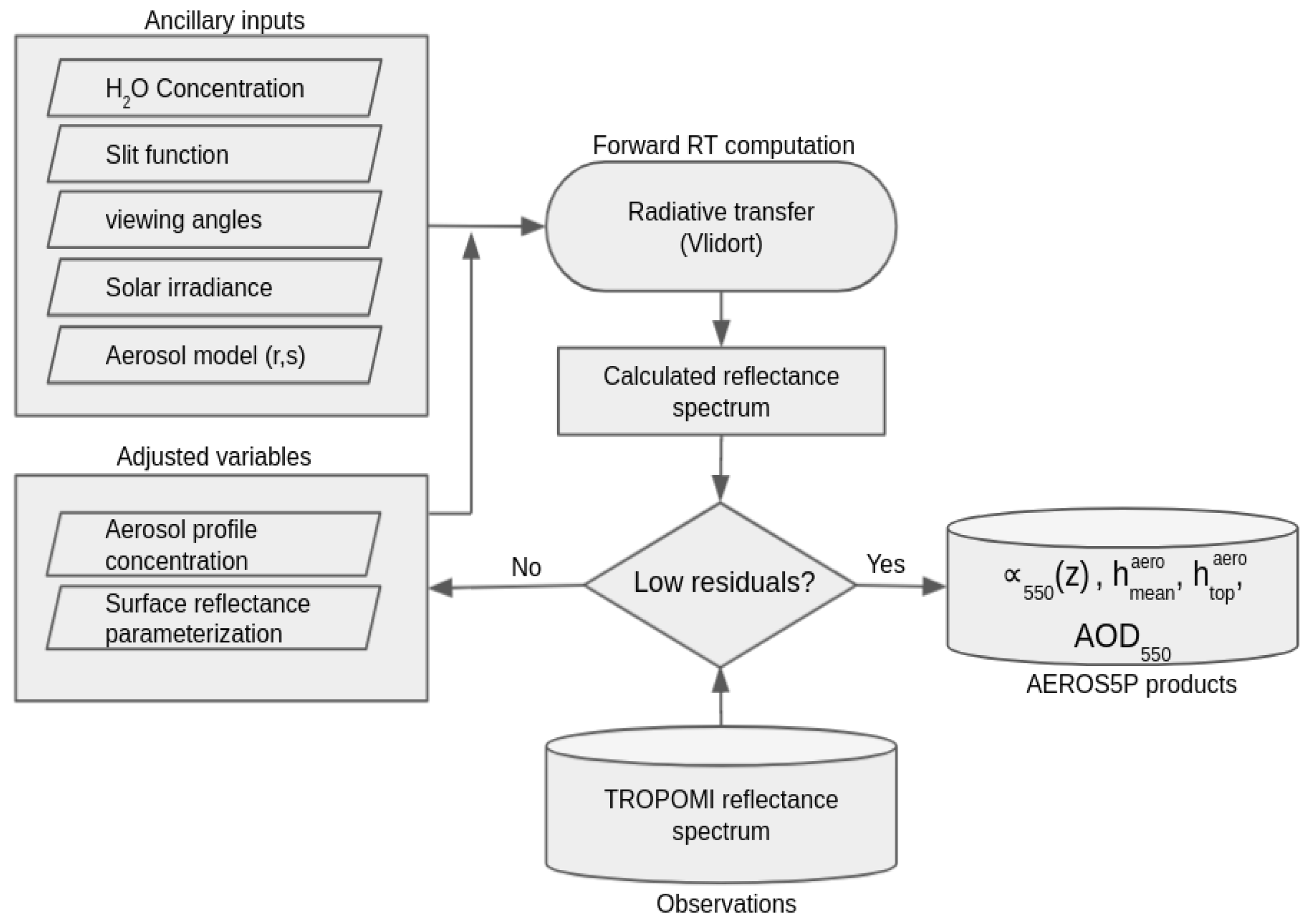
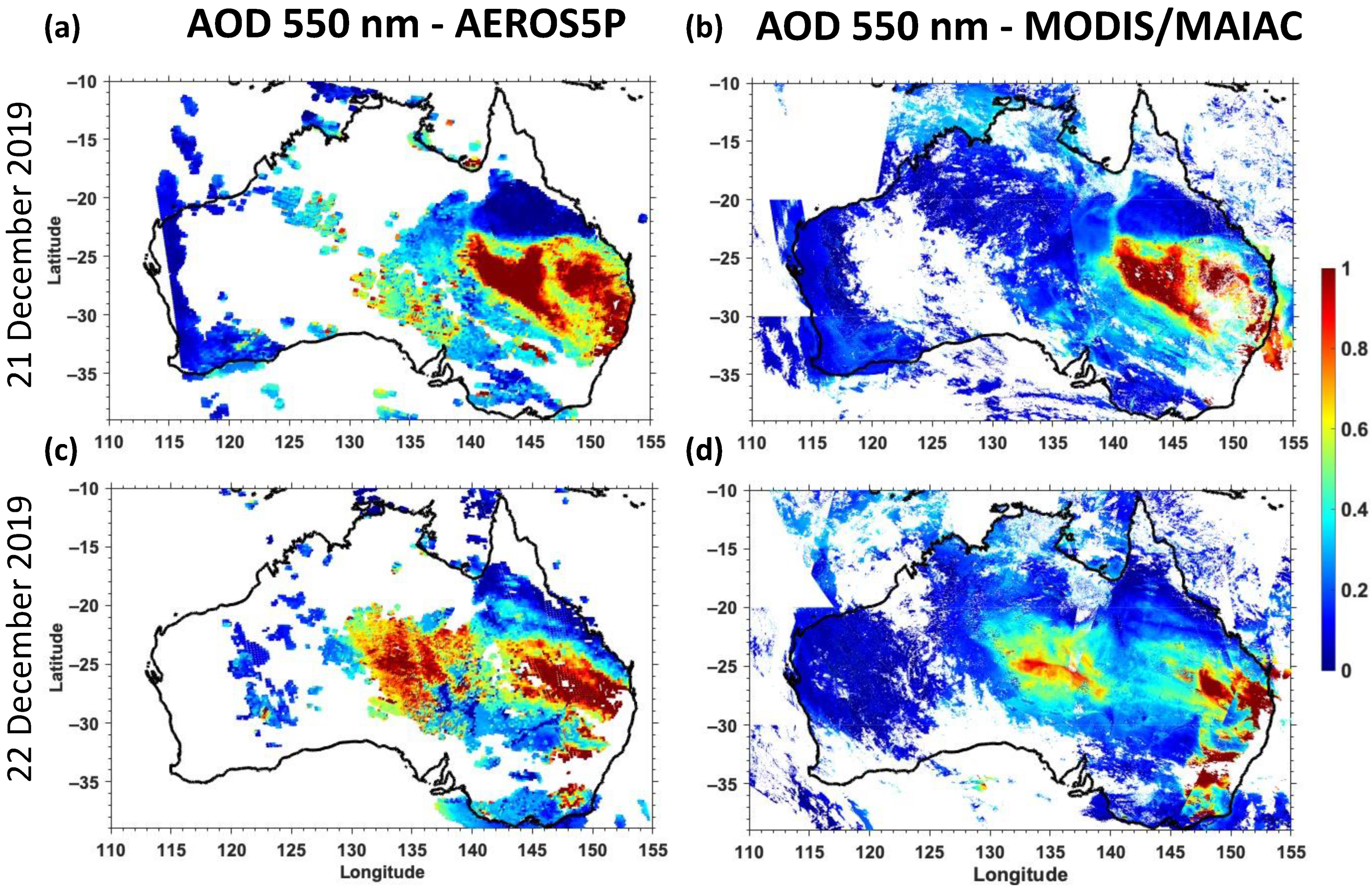
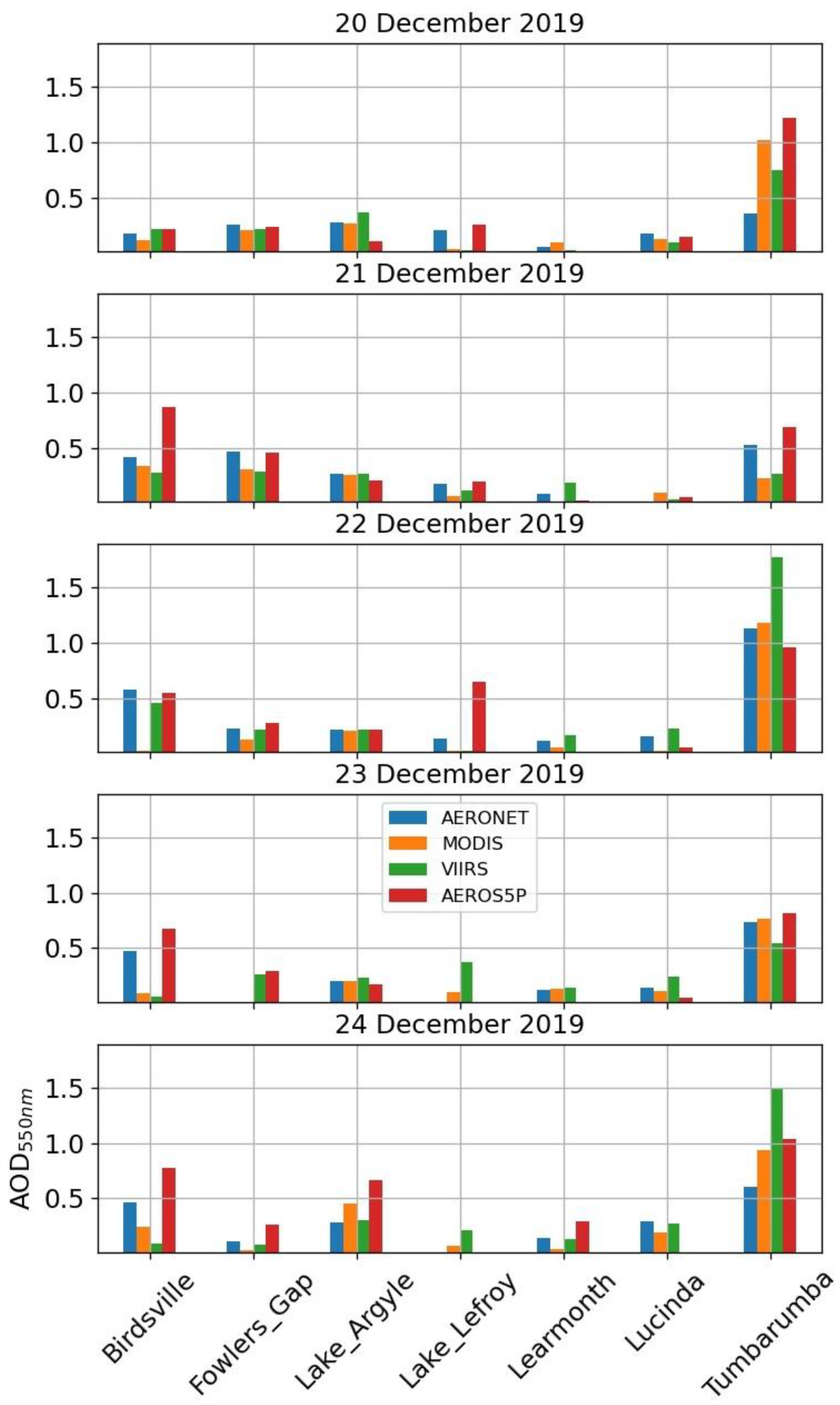

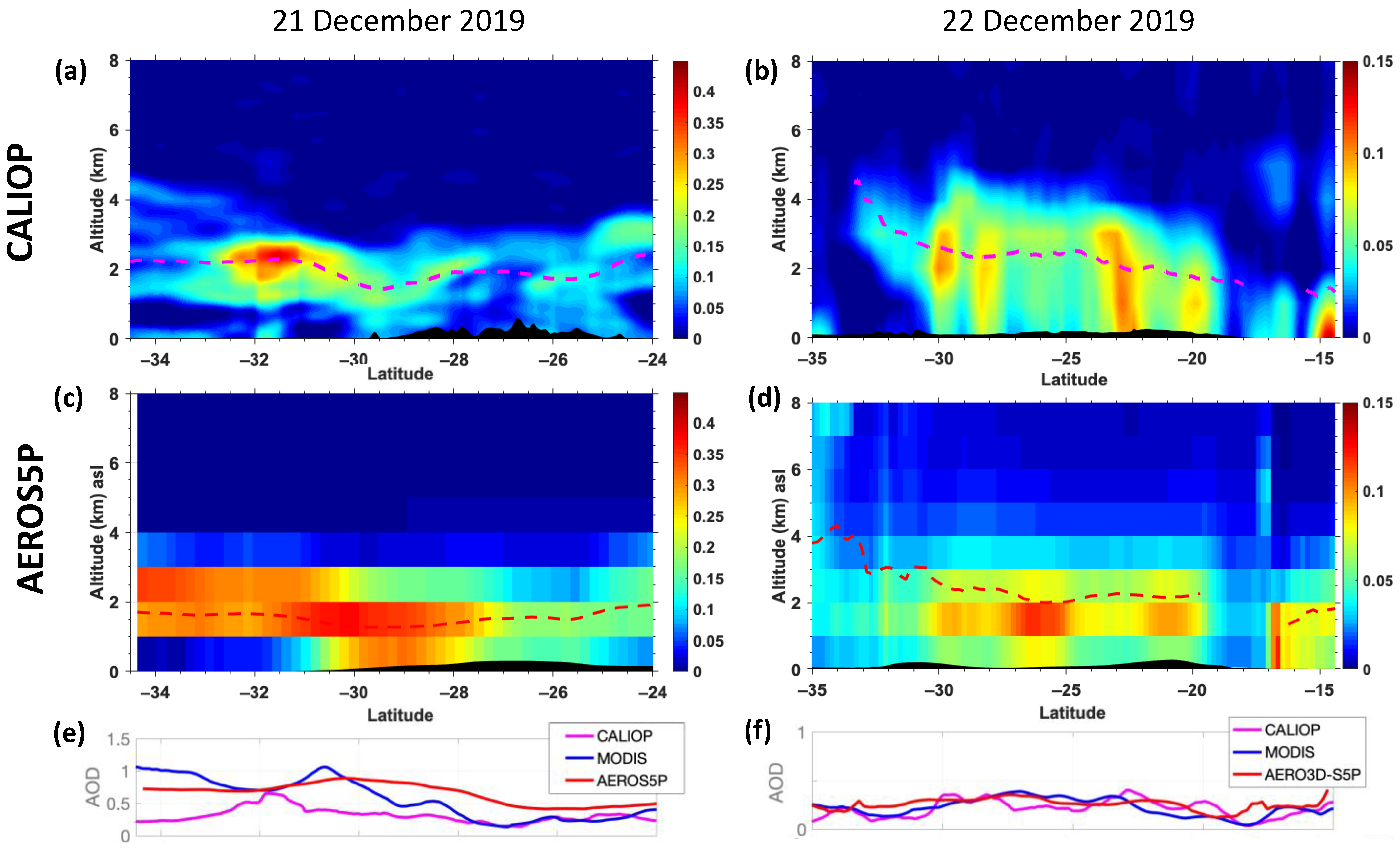
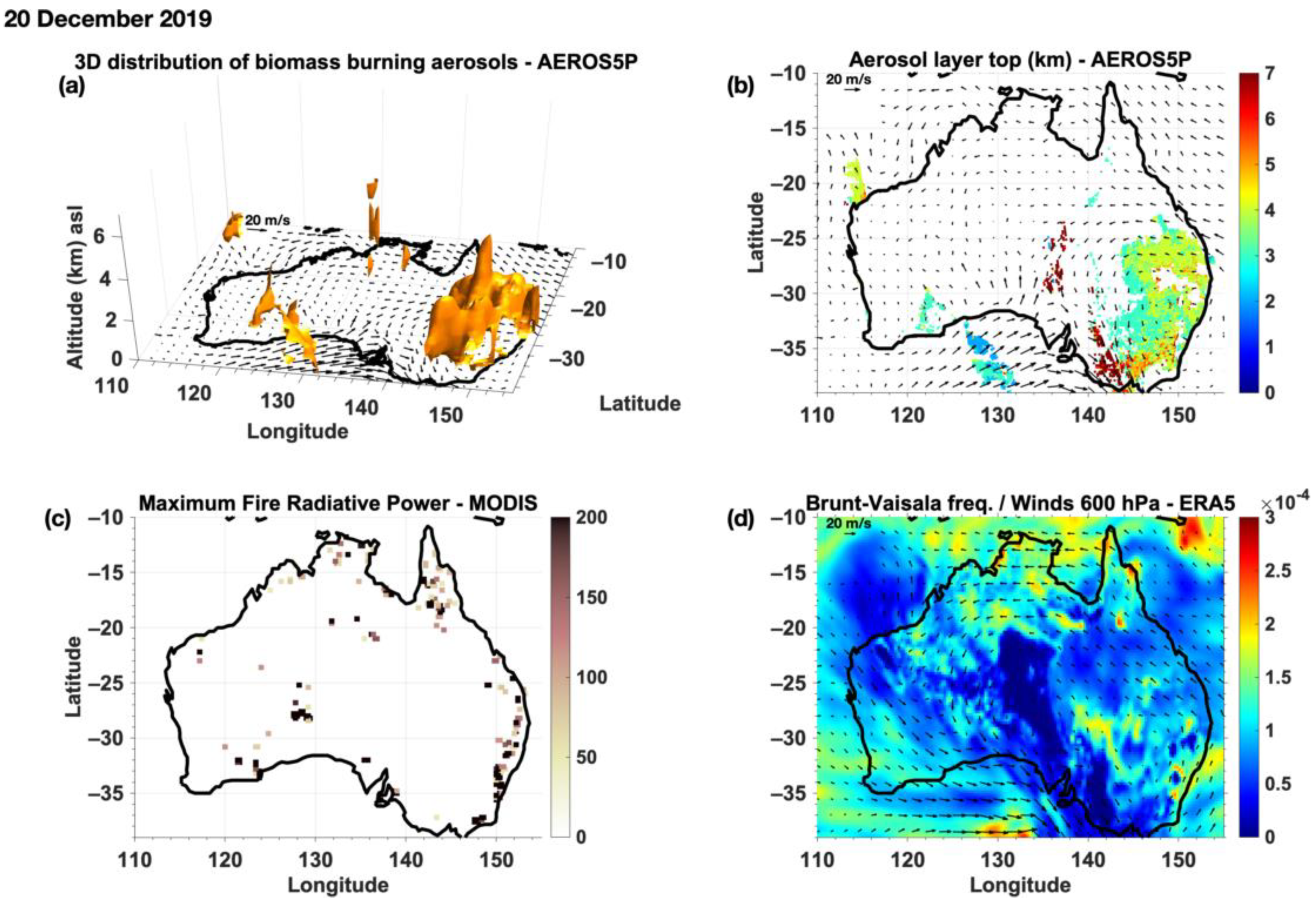
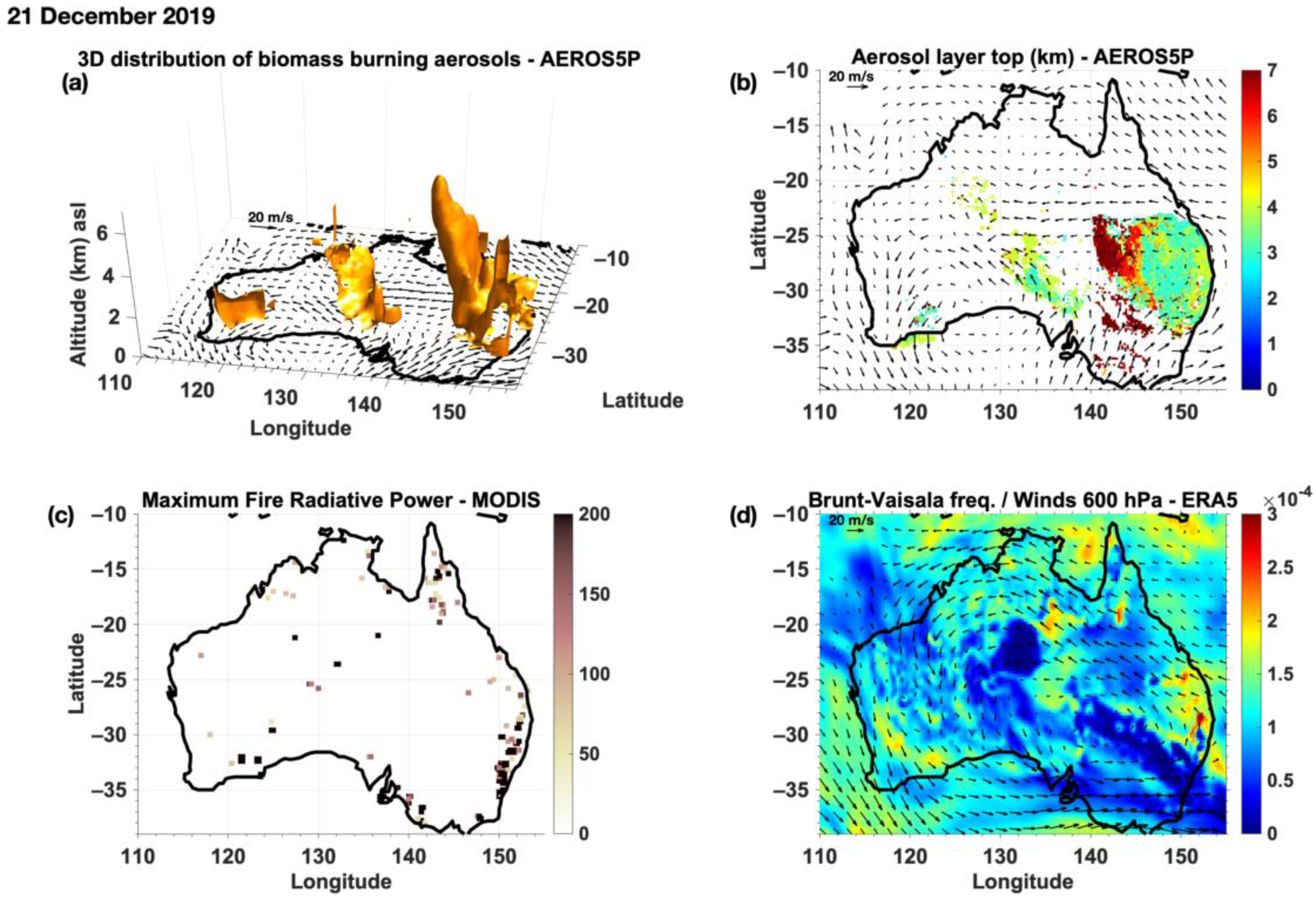
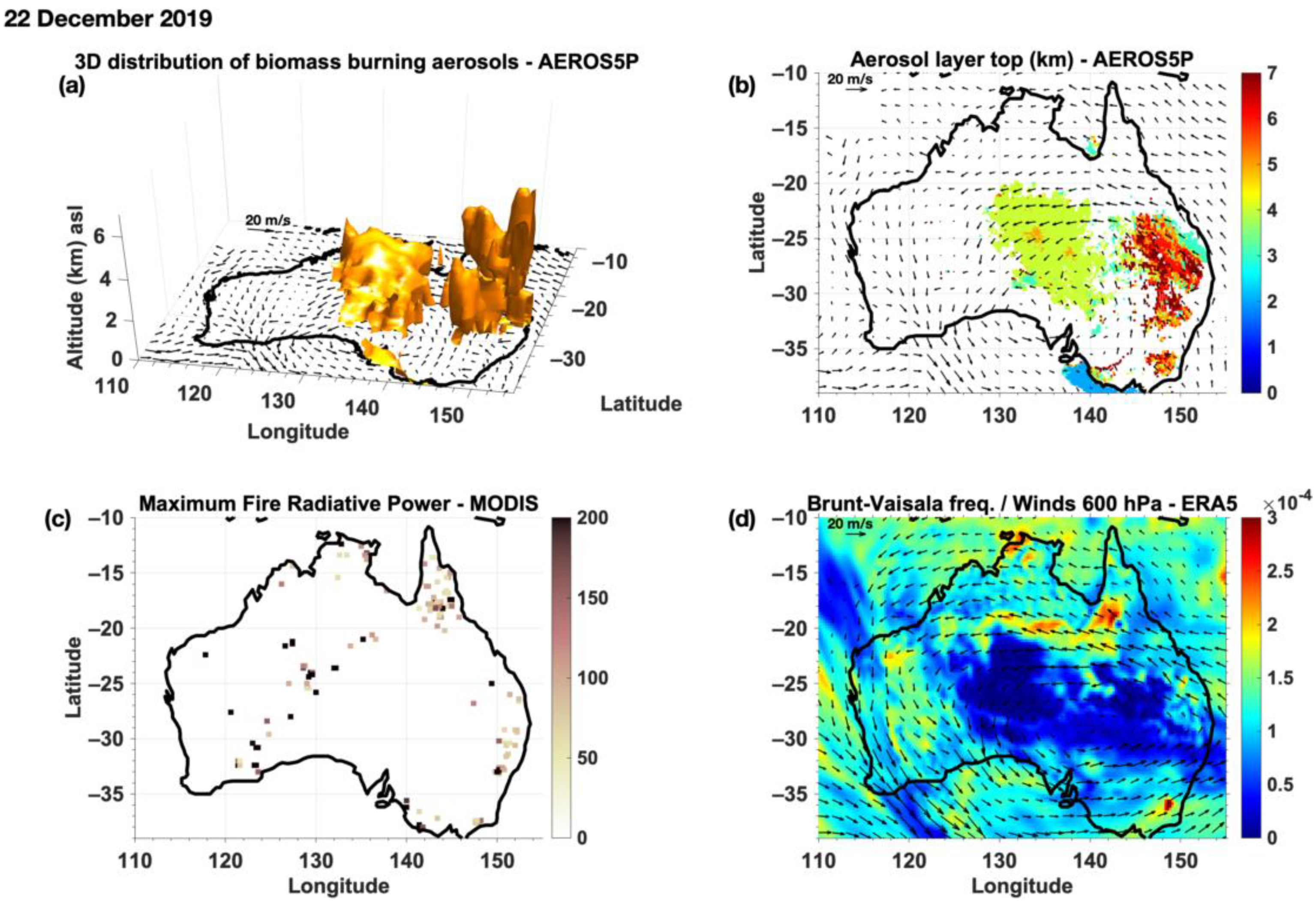
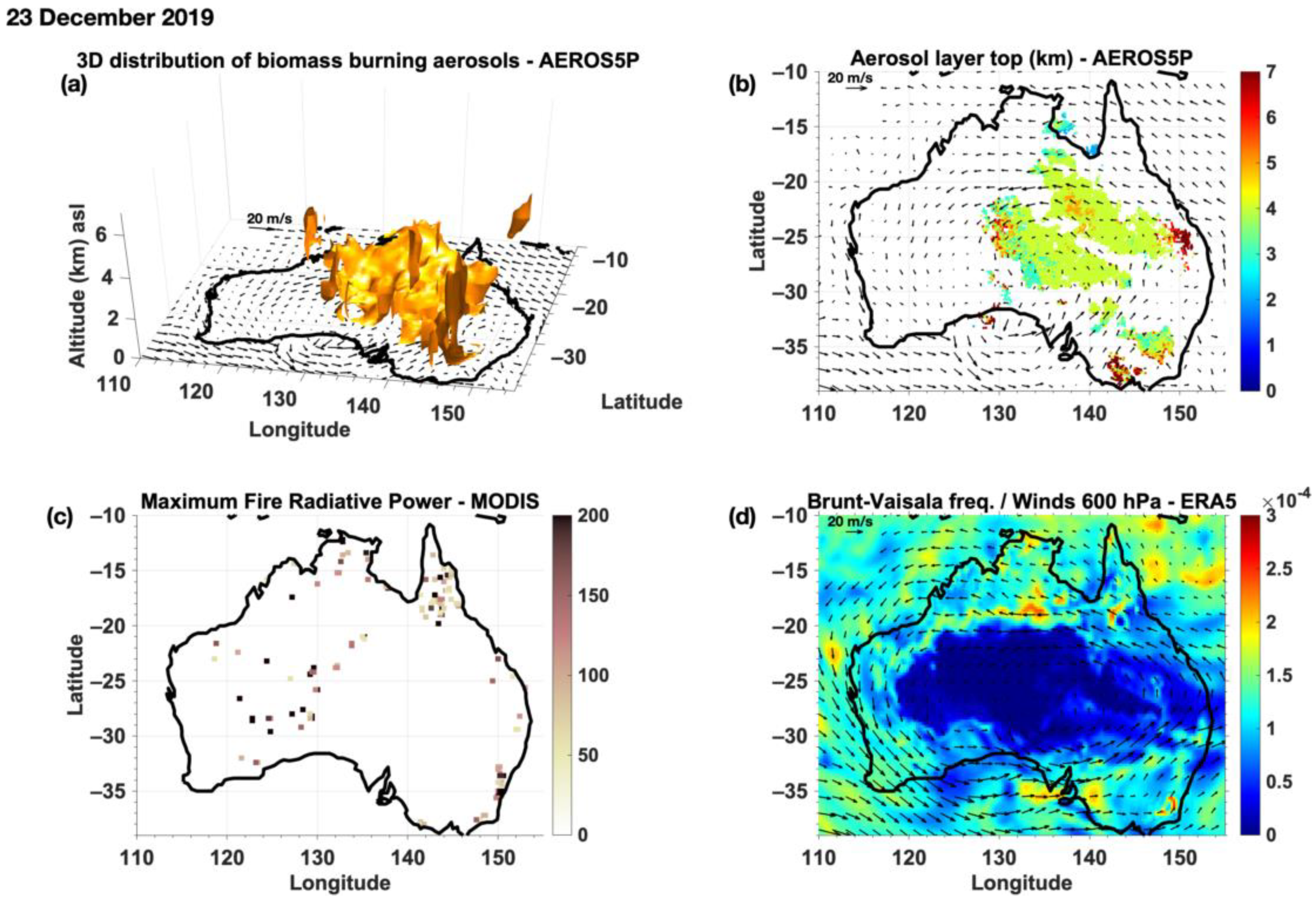
| Variable | Characteristics | |
|---|---|---|
| TROPOMI measurements | Reflectance spectra | 12 microwindows * at 406, 416, 425, 436, 442, 451.5, 463, 477, 483, 494.5, 674.5 and 766.5 nm |
| Meteorological state | Temperature profile | ERAI reanalyzes |
| Pressure profile | ERAI reanalyzes | |
| Water vapor profile | ERAI reanalyzes | |
| Atmospheric species | A unique a priori aerosol concentration profile | Homogeneous concentration up to 9 km corresponding to a background AOD of 0.03 at 550 nm |
| BB aerosol refractive indices | From [52] | |
| Oxygen vertical profile | A constant mixing ratio of 0.209 | |
| Aerosol size distribution | A modal radius around 0.1 µm and width of 1.43 taken from AERONET retrievals at Birdsville on 22 December 2019 | |
| Gas absorption cross sections | Oxygen absorption cross sections | Calculation using HITRAN 2012 [49] spectroscopic parameters, line mixing, H2O broadening and collision-induced absorption following [53] |
| H2O absorption cross sections | From HITRAN 2012 [49] | |
| Geophysical state | Solar spectrum | High spectral measurements from [50] |
| Surface albedo | DLER at 19 wavelengths, 0.125 × 0.125°, version 0.3 from the TROPOMI s5p+ Innovation project [51] | |
| Instrumental calibration | Soft correction | Adapted from the soft correction for the OCRA cloud retrieval [46,47] |
| Instrumental spectral response | Slit function provided for each swath position and wavelengths from [54] |
| Aerosol Type | r | RMSE | MAE | Number of Co-Located Pixels |
|---|---|---|---|---|
| Smoke | 0.82 | 0.69 | 0.49 | 667 |
| Non-smoke fine mode | 0.86 | 0.30 | 0.24 | 3168 |
| Mixed | 0.23 | 0.35 | 0.21 | 5868 |
| Background | 0.24 | 0.20 | 0.13 | 8595 |
Publisher’s Note: MDPI stays neutral with regard to jurisdictional claims in published maps and institutional affiliations. |
© 2022 by the authors. Licensee MDPI, Basel, Switzerland. This article is an open access article distributed under the terms and conditions of the Creative Commons Attribution (CC BY) license (https://creativecommons.org/licenses/by/4.0/).
Share and Cite
Lemmouchi, F.; Cuesta, J.; Eremenko, M.; Derognat, C.; Siour, G.; Dufour, G.; Sellitto, P.; Turquety, S.; Tran, D.; Liu, X.; et al. Three-Dimensional Distribution of Biomass Burning Aerosols from Australian Wildfires Observed by TROPOMI Satellite Observations. Remote Sens. 2022, 14, 2582. https://doi.org/10.3390/rs14112582
Lemmouchi F, Cuesta J, Eremenko M, Derognat C, Siour G, Dufour G, Sellitto P, Turquety S, Tran D, Liu X, et al. Three-Dimensional Distribution of Biomass Burning Aerosols from Australian Wildfires Observed by TROPOMI Satellite Observations. Remote Sensing. 2022; 14(11):2582. https://doi.org/10.3390/rs14112582
Chicago/Turabian StyleLemmouchi, Farouk, Juan Cuesta, Maxim Eremenko, Claude Derognat, Guillaume Siour, Gaëlle Dufour, Pasquale Sellitto, Solène Turquety, Dung Tran, Xiong Liu, and et al. 2022. "Three-Dimensional Distribution of Biomass Burning Aerosols from Australian Wildfires Observed by TROPOMI Satellite Observations" Remote Sensing 14, no. 11: 2582. https://doi.org/10.3390/rs14112582
APA StyleLemmouchi, F., Cuesta, J., Eremenko, M., Derognat, C., Siour, G., Dufour, G., Sellitto, P., Turquety, S., Tran, D., Liu, X., Zoogman, P., Lutz, R., & Loyola, D. (2022). Three-Dimensional Distribution of Biomass Burning Aerosols from Australian Wildfires Observed by TROPOMI Satellite Observations. Remote Sensing, 14(11), 2582. https://doi.org/10.3390/rs14112582






